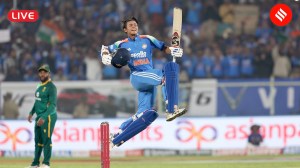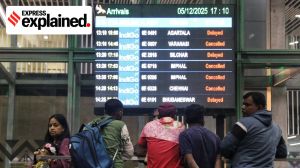Decode Politics: As ULFA formally disbands, tracing its nearly half-century journey, with some miles to go
The pro-talks faction that signed a peace accord with the government last month wrapped up, admitting they were doing so "without attaining our objective" but being left with "no option". Meanwhile, the Paresh Baruah faction holds out.
 Last Thursday, ULFA general secretary Anup Chetia (left), along with other senior members of the outfit, met Assam Chief Minister Himanta Biswa Sarma (right) to convey him about the group's disbanding. (File Photos)
Last Thursday, ULFA general secretary Anup Chetia (left), along with other senior members of the outfit, met Assam Chief Minister Himanta Biswa Sarma (right) to convey him about the group's disbanding. (File Photos)The United Liberation Front of Asom (ULFA) formally disbanded last week, 44 years after its formation as per the conditions of a tripartite agreement signed by it last month with the Centre and the Assam government. The agreement, signed on December 29, stated that “ULFA shall abjure the path of violence, give up all arms/ammunition and disband the armed organisation within one month”.
After the pro-talks faction held its last ‘general council meeting’ on January 23, its general secretary and one of the ULFA’s founding members, Anup Chetia, said disbanding the outfit was “an emotional decision and a painful moment for us”. “We gave birth to this organisation in 1979 and had to disband it today without attaining its objective. We failed in our armed struggle and had no option but to accept what we could get for people by signing the peace accord,” Chetia said.
At the meeting held in the Darrang district, the outfit also apologised to the people of Assam for its “mistakes” and “activities” over the course of its 44-year armed struggle.
Last Thursday, Chetia and pro-talk ULFA faction chairman Arabinda Rajkhowa, along with other senior members of the outfit, met Assam Chief Minister Himanta Biswa Sarma to convey him about the group’s disbanding. Soon after, Sarma posted on X: “Three cheers to new beginnings! Following the historic December 29th 2023 agreement signed under the leadership of Hon’ble Union Home Minister Shri @AmitShah ji, the leadership of ULFA (Pro Talks) disbanded their erstwhile insurgent organisation and constituted a new socio-cultural platform, the Asom Jatiya Bikash Mancha, to serve the people of Assam through democratic means. Their leadership met me to communicate this decision in person… An entire generation in our state grew up thinking such a transition was impossible. Our immense gratitude to Hon’ble Prime Minister Shri @narendramodi ji, for his vision of a Viksit Bharat has inspired many groups to join the path of peace and progress.”
The ULFA was formed on April 7, 1979, in Sivasagar by a group of 20 youths from Upper Assam districts to establish a “sovereign Assam” through an armed struggle. In 2011, the outfit split, with its top leadership, including Rajkhowa, returning to Assam from a neighbouring country and agreeing to talks without the sovereignty clause, while submitting a 12-point charter of demands to the central government.
However, the other faction of the outfit, ULFA (Independent), led by Paresh Barua, remains firm on its demand for sovereignty and is yet to come for talks.
What happens now?
At the final council meeting, the outfit declared the formation of a seven-member monitoring committee led by Chetia to ensure that the clauses of the peace accord with the government were fulfilled. It also announced the formation of the Asom Jatiya Bikash Mancha, a socio-cultural organisation, with the mandate to protect the cultural and linguistic identity of Assamese society.
Mrinal Hazarika, a pro-talks faction leader, also said ULFA cadres may be reorganised and rehabilitated to engage in “productive economic activities”.
Nine of the ULFA’s camps, where the group’s members were staying since peace talks with the government began in 2011, will now be vacated. Before January-end, the group is also expected to relinquish any arms and ammunition in its possession to the government in a formal ceremony.
What are some key features of the accord?
The major features of the peace accord, signed on December 29 in the presence of Amit Shah, Sarma, Rajkhowa and others, include assurances to restrict representation to tribal communities in 97 of the state’s 126 Assembly constituencies and ensure Constitutional safeguards for them. The deal also restricts the migration of voters across constituencies, promises to protect the land rights of the state’s “indigenous people”, and to implement a Rs 1.5 lakh crore socioeconomic development package for Assam.
How and why was the ULFA formed?
Founded in 1979, the ULFA began as a separatist political movement, but transformed into an armed struggle for a “sovereign socialist Assam”.
The roots of the movement go further back to 1947, when India gained Independence and the Partition saw more than four million Bengalis from erstwhile East Pakistan migrate across the border. With the arrival of migrants and refugees, a sense of insecurity arose among the Assamese, who feared a dilution of their culture and languages. The war to liberate Bangladesh in 1971 led to the influx of more refugees into West Bengal and Assam.
In 1979, the All Assam Students’ Union began a six-year movement against illegal migration, which ended in 1985 with the Assam Accord, under which the government agreed to fence the international border with Bangladesh and deport refugees and migrants who had entered India after 1971.
In the midst of all this, Bhimakanta Buragohain, Arabinda Rajkhowa, Anup Chetia, Pradip Gogoi, Bhadreshwar Gohain and Paresh Baruah formed the ULFA in April 1979, claiming it had “social sanction”, with the objective to create a separate Assam nation through an armed struggle.
The organisation’s political wing started with Rajkhowa as its chairman, Gogoi as the vice chairman, Chetia as the general secretary, Sashadhar Choudhury as the foreign secretary, Chitraban Hazarika as the finance secretary, and Baruah at the head of the military wing as the chief of army staff – all self-styled positions.
How have the ULFA and Assam’s political landscape changed over the years?
Within the ULFA, there have been several instances of differences of opinion, and the outfit has seen a few splits, the first major one coming in 1992, when some leaders expressed a desire to negotiate with the Indian government. However, the main command structure of the outfit – Rajkhowa and Baruah – stood firm on their demands for a “sovereign” Assam.
In the early 1990s, a faction called the Surrendered ULFA (SULFA) offered to surrender and negotiate with the government. The SULFA was formidable in the 1990s and early 2000s, when state governments were accused of using the outfit in “secret killings” of relatives of ULFA members in hiding.
Beginning in 1990, with Operation Bajrang through which 1,221 insurgents were arrested, the Centre launched widespread efforts to root out the ULFA. In the same year, Assam was declared a “disturbed area”, the then Asom Gana Parishad (AGP) government was dissolved, and President’s Rule was imposed. The Armed Forces Special Powers Act (AFSPA) was also imposed and the ULFA was outlawed.
Under the subsequent Congress government, ULFA hostilities continued. In September 1991, the Indian Army began the anti-insurgency Operation Rhino. In 1996, after the AGP returned to power, the state began a coordinated plan to contain the insurgency, involving the police, Army, paramilitary forces and the administration.
What were the ULFA’s cross-border operations?
As ULFA was increasingly cornered in Assam in the 1990s, it sought shelter in the jungles of southern Bhutan, where it developed links with Royal Bhutan Army (RBA) officials and maintained 13 major camps along the Indo-Bhutan border.
But in 2003, the RBA’s Operation All Clear flushed out the ULFA, which then shifted its base to Myanmar. The ULFA had first established contact in 1986 with other insurgents operating in Myanmar, including the Kachin Independence Army and the Nationalist Socialist Council of Nagaland, from whom the ULFA received training and arms. The ULFA also forged alliances with other insurgent groups in the Northeast operating out of Myanmar to form the Indo-Burmese Revolutionary Front in 1989.
The ULFA also had a presence in Bangladesh since 1989. Not only did it have an estimated 13 to 14 camps at the time, it also established businesses, many of which were alleged to be owned by Baruah, in Bangladesh. In 1997, the ULFA operations came to a halt after Chetia was arrested by the Bangladeshi authorities.
During this time, the ULFA was also said to have established links with Pakistan’s Inter-Services Intelligence and the Afghan Mujahideen. The ULFA openly supported Pakistan in its monthly newsletter ‘Swadhinata (freedom)’ during the Kargil War.
How did the pro-talks faction come about?
After decades of violence, the ULFA formed an 11-member People’s Consultative Group in 2005 to hold talks with the government. After three rounds of talks, the ULFA walked out of the discussions.
But in 2008, the ULFA declared a unilateral ceasefire. Its chairman Rajkhowa was arrested in Bangladesh in 2009 and extradited to India, where he was jailed in Guwahati.
In jail, some ULFA leaders formed a ‘Citizens Forum’, involving authors, journalists and academics, to initiate peace talks with the government. While Rajkhowa and others were released from jail in 2011, Chetia was released from a Bangladeshi jail in 2015.
In 2011, the ULFA’s general council endorsed a proposal to start unconditional peace talks with the government. However, Baruah was opposed to the talks and in 2012, he “expelled” Rajkhowa and “appointed” a new ULFA chairman. In turn, the pro-talks faction led by Rajkhowa “expelled” Baruah, who then floated the ULFA (Independent).
While a majority of the ULFA joined the peace talks, an estimated 150-250 militants, mostly fresh recruits, stayed back in the jungles.
In 2012, the pro-talks faction submitted a 12-point charter of demands to the Central government. However, the government’s response to the demands came only in April 2023.
While Baruah remains elusive and the ULFA(I) continues hostilities, the peace agreement is expected to be the beginning of a solution, albeit termed ‘incomplete’ by many, to the four-decade insurgency. In 2021, CM Sarma had offered to cease hostilities with the ULFA(I), but it was declined.
- 01
- 02
- 03
- 04
- 05






























